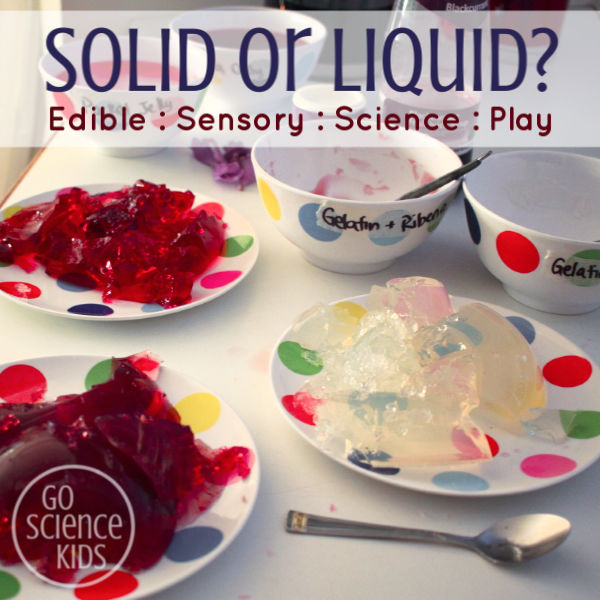 This activity started out with my three year old daughter Bumble Bee asking if she could make jelly. Specifically, she wanted to make “jelly on a plate that wibble wobbles, just like the song“. Hmmm…. Jelly is a treat that we normally reserve for parties, but I figured if I could turn her jelly making experience into an edible science experiment exploring the difference between liquids and solids, then I might be able to justify serving it at home, just this once!
This activity started out with my three year old daughter Bumble Bee asking if she could make jelly. Specifically, she wanted to make “jelly on a plate that wibble wobbles, just like the song“. Hmmm…. Jelly is a treat that we normally reserve for parties, but I figured if I could turn her jelly making experience into an edible science experiment exploring the difference between liquids and solids, then I might be able to justify serving it at home, just this once!
Suitable for
This is a fun and safe science exploration for toddlers and up! When we did this, Bumble Bee was just over three years old and Jewel was around five and a half.
In case you haven’t heard this nursery rhyme before, it goes like this:
Jelly on a plate.
Wibble, wobble, wibble, wobble,
Jelly on a plate!
Before I continue, I should clarify something. What we call jelly in Australia, is the same thing that some people call jello (or Jell-O). And what we call gelatine is the same thing as some people call gelatin. In this post, I’m referring to jelly as a dessert, not jelly as a spreadable fruit preserve (which we call jam). OK? Sorry for the confusion, it’s an English language thing…
Anyway, back to our jelly science experiment. When I said yes, Bumble Bee was so excited! (She’d been watching her sister make potions and was so keen to get in on the science action!)
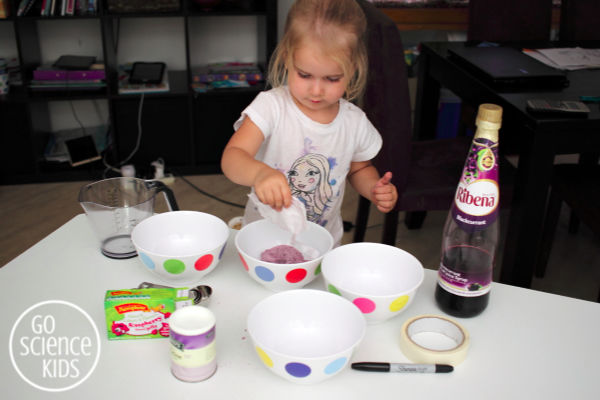
We set ourselves up with four different bowls, to make four different jelly / gelatine mixtures, so we could make observations and comparisons. We made:
- one bowl with a store-bought packet jelly mix and hot water
- one bowl with pure gelatine and hot water
- one bowl with pure gelatine and hot water mixed with Ribena
- one bowl with hot water mixed with Ribena only
I used masking tape and a marker to label each of our bowls, partly to keep track of which bowl was which, and partly because labelling things makes it feel like an official science experiment, which is fun! (At this age, role playing ‘doing a science experiment’ is as much a part of the playful learning experience as the actual experiment itself.)
Of course, we had to taste the jelly and gelatine crystals. This is supposed to be a multi-sensory experience, after all! Jewel definitely preferred the taste of the packet jelly crystals over the plain gelatine crystals. We also noticed that the crystals looked different too – the packet jelly crystals were coloured, and clumped together, whereas the gelatine crystals were small, fine and didn’t stick together.

We made predictions about what would happen to each bowl when hot water was added.
We used hot water from the tap (which is set at a non-scalding temperature), rather than boiling water from the kettle, so that Bumble Bee could pour the water herself. She felt very responsible doing all the measuring, pouring and stirring. Whilst the non-boiling water did mean that the jelly and gelatine crystals didn’t dissolve as quickly, and there may have been some left undissolved at the bottom of the bowls, it was more important that she enjoy the feeling of independence at being able to do it all by herself.
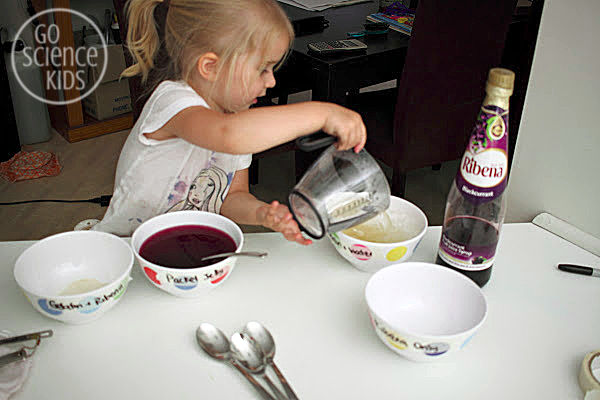
We talked about how all four bowls contain liquids. We talked about what the word liquids means, and how liquids are runny and become the same shape as the container holding it.
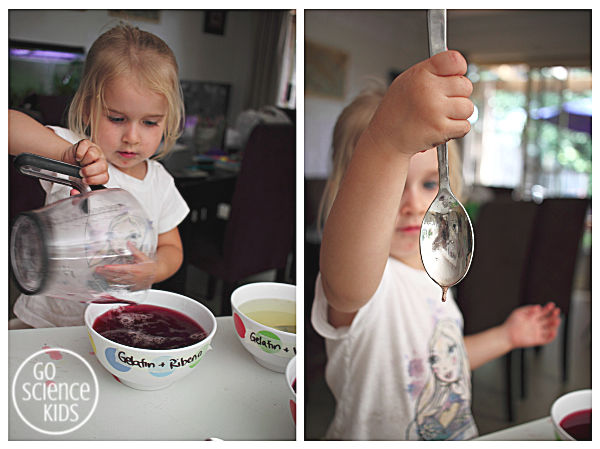
Bumble Bee had a fair idea (based on previous experience with jelly) that some of the jelly bowls would set, but she wasn’t sure which ones. She did notice that the gelatine bowls were setting quickly though, with some of the mixture sticking to her spoon!
We put all the bowls in the fridge, returning a little while later to see what, if anything, had changed.
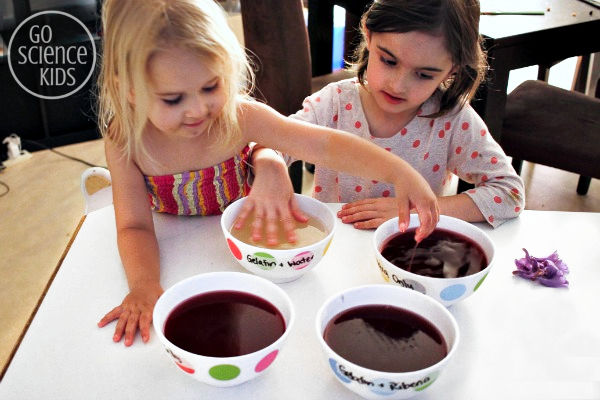
Bumble Bee’s 5.5 year old sister Jewel decided to join in for the second half of this experiment. We took the bowls out of the fridge. The first thing the girls noticed was the temperature change – the bowls were a lot colder than before.
They also noticed that three of the bowls had turned into jelly and resisted your touch. But the fourth bowl (that one that contained Ribena only), was still runny. You could put your fingers in it, and it left your fingers wet.
We tasted all the bowls to make comparisons. The girls equally liked the packet jelly bowl, and the bowl that contained Ribena and gelatine. They also enjoyed the bowl that contained the liquid Ribena, and noticed that it tasted similar to the Ribena they’ve previously drunk from a cup, only colder! They also tasted the gelatine only bowl, and thought that it didn’t really taste like anything.
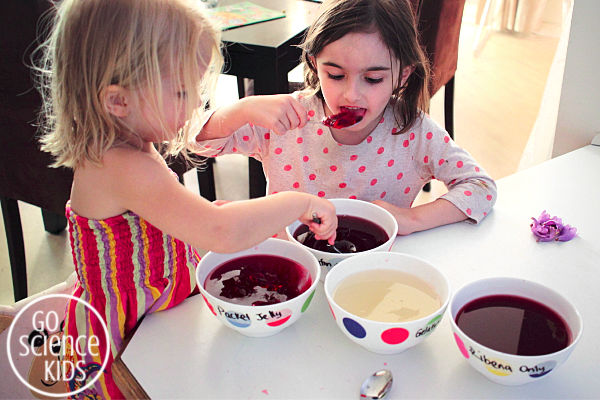
We talked about how liquids change shape, depending on the container they are in. Whereas, solid things have their own shape. To test out this theory, we turned over the three bowls of jelly onto plates, and noticed that they stayed in the shape of the upside down bowl, even after the bowl was removed. They didn’t spill all over the table. We didn’t upturn the fourth bowl with Ribena only, as the kids correctly guessed that this would make a huge mess!
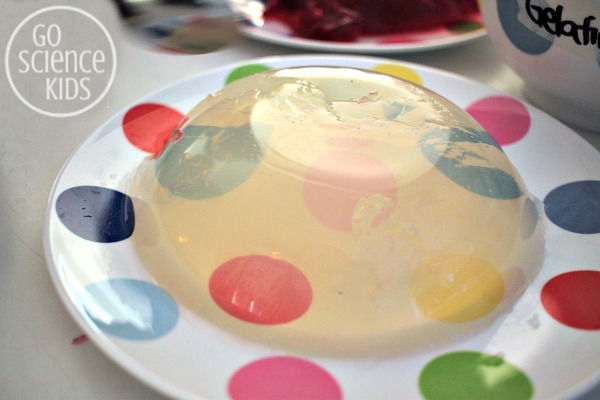
Based on previous experiences with jelly melting at warm weather birthday parties, we talked about how if we left our jelly outside in the sun, our jelly might change from a solid back into a liquid and melt everywhere.
They started to break the jelly apart, and noticed that while the pieces became smaller, it still didn’t flow like water or other liquids would. The kids then took the opportunity to squish jelly between their fingers. It has such a delightful texture! And there might have been a bit more tasting testing too. 🙂
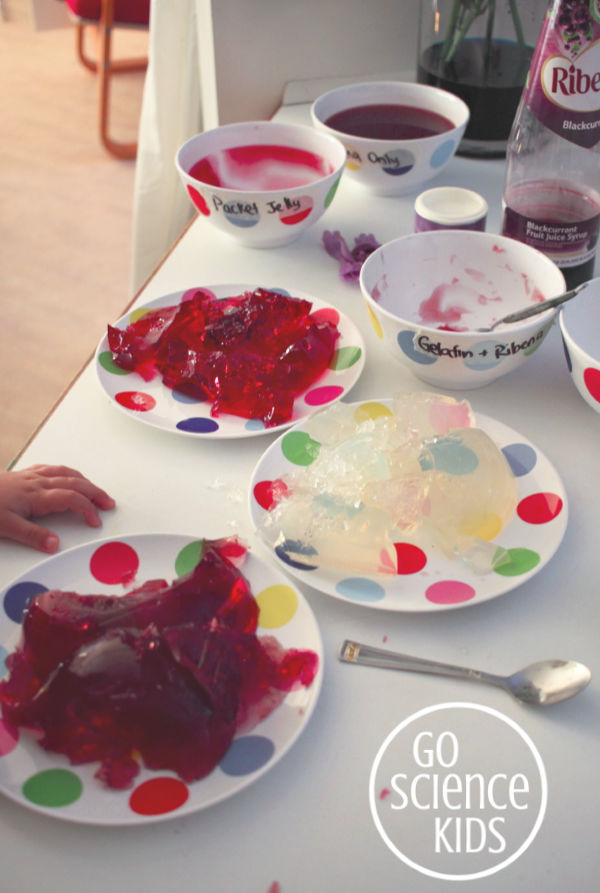
What is a solid?
Matter is the name that scientists call everything around us (or more specifically, everything that has mass and takes up space). Basically, anything you can see, touch, or even breath is called matter.
There are three main states of matter: solids, liquids and gases. (There are others, but these are the ones kids will come in contact with in their everyday lives.)
A solid, like a carrot or a pencil, is something that has a stable shape. Their molecules are packed tightly together in organised patterns. Solids can be large or small, hard or soft. Whilst you might be able to break a solid apart, it doesn’t tend to come apart all on it’s own.
A liquid, like water or juice, has volume, but changes shape depending on the container that it is in. The molecules are close together, but move around. Liquids flow.
A gas, like air or helium, are free-flowing. You can easily put your hand through gases. They don’t have a consistent volume, and can shift to fit their container, or even fill it. Their molecules are spaced far apart and wiggle around.
Jelly or Gelatine is made up of a protein which dissolves in hot water. As the water cools, the protein molecules come out of the solution and turn back in to a solid, but instead of settling at the bottom of the bowl, they stick together in a complex matrix, catching the water molecules within, and create a sort of solid-liquid limbo. The colder the jelly, the more solid-like it will be. As jelly warms, the protein structure becomes dissolved again, and it will turn back into a liquid.

For more sensory edible science ideas, you might also like:
- How to make taste-safe glowing ice cubes, which are fun for sensory play on a hot day!
- Learn about how glass is made, with this edible glass recipe that really shatters
- See how much you taste with your eyes by experimenting with two types of watermelon.
- Try an all natural ‘miracle berry’ to temporarily confuse your taste buds into thinking that sour foods taste sweet.


#
This looks like such a fun activity… jelly is such cool stuff, and delicious too!
#
I LOVE your experiments, they are perfect for our family, thank you 🙂
#
Thanks Chelsea!